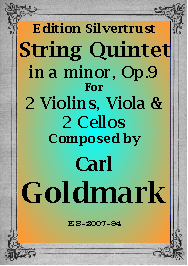Presents
Carl Goldmark
String Quintet in a minor, Op.9
For 2 Violins, Viola & 2 Cellos
 "The
Op.9 String Quintet is a mature work of masterly construction and may be
regarded as one of Goldmark's finest chamber works." So wrote the respected
critic Rudolf Felber in his article on Goldmark in Cobbett's Cyclopedic Survey
of Chamber Music.
"The
Op.9 String Quintet is a mature work of masterly construction and may be
regarded as one of Goldmark's finest chamber works." So wrote the respected
critic Rudolf Felber in his article on Goldmark in Cobbett's Cyclopedic Survey
of Chamber Music.
Carl Goldmark (1830-1915) was born in the town of Keszthely in Austria-Hungary. His early musical training was at the conservatories in Sopron and Odenburg. His father then sent him to Vienna where he briefly studied violin under two of the better known teachers, Leopold Jansa and Joseph Böhm. As a composer, however, Goldmark was largely self-taught.
World-wide fame came to him with the performance of his opera The Queen of Sheba. He wrote in most genres and many of his other compositions, such as his Violin Concerto and the Rustic Wedding Symphony, were quite popular during his lifetime and for several years thereafter. His chamber music was well-thought of and also received concert performances while he was alive but sadly disappeared from the concert stage after his death. Brahms was to become a good friend but Goldmark's chamber music does not show much of that composer's influence. Rather, one sometimes hears an interesting mix of Mendelssohn and Schumann often seasoned with lively Hungarian gypsy melodies.
The String Quintet dates from 1870 and is certainly one of the best in the literature for this combination. Felber describes of the Quintet as follows:
The opening Allegro reveals
fresh invention and wealth of imagination; here the composers characteristic
tendency to Oriental coloring already appears. The first theme, full of pathos
and the meditative second theme provide an excellent contrast. There is also a
third theme--all three are splendidly developed. The end of this movement is
particularly beautiful and the skillful interweaving of the parts makes a deep
impression. The deeply emotional second movement, Andante con moto, shows
the influence of Mendelssohn. The third movement is a gay Scherzo. In the
finale begins in a funereal vein with a substantial, Andante sostenuto,
introduction. But the main part of the movement, Allegro, is
lively and high-spirited. (our sound-bite Presents
the last few seconds of the
Andante and then the first part of the Allegro)
Long out of print, we are pleased to reintroduce this fine work which not only deserves concert performance but will also be a great pleasure to amateurs.
In addition, we are pleased to offer this Quintet in a version for 2 Violins, Violas, Cello and Bass. Our bass part was made by Anthony Scelba, noted bass soloist, Professor of Music and Director of the Concert Artists Program of Kean University. Professor Scelba has created an idiomatic bass part that adds breadth and clarity to the timbral spectrum of the work, making it a welcome addition to the double bass chamber music repertoire.